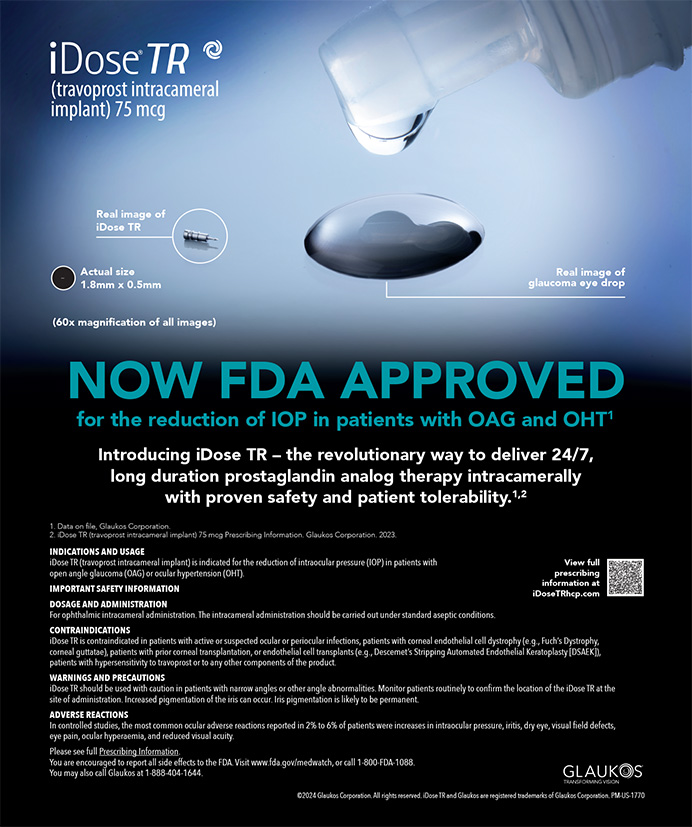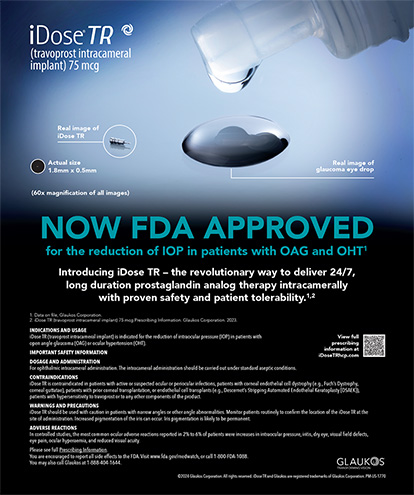Cataract Surgery | Jul 2005
Scientific Studies and Their Clinical Relevance
The implications for cataract incisions.
Paul H. Ernest, MD, and Thomas Neuhann, MD
Recently, ophthalmologists have exhibited a renewed interest in the construction of cataract incisions concurrent with a growing concern that sutureless clear corneal incisions are associated with an increased risk of postoperative endophthalmitis. The argument goes that, especially with lower IOPs, such incisions may—spontaneously or upon inadvertent minor deformation—gape and allow an influx of conjunctival fluid into the eye. Other surgeons dismiss such arguments, because they have not observed an increase in infections in their patients.
This debate demonstrates the value of reviewing a few basic principles for scientifically approaching such clinically relevant questions, how experimental laboratory studies are properly set up, and how to establish the clinical relevance of their results.
CONSTRUCTING A SCIENTIFIC STUDY
Scientific engineering contains all the principles for designing experimental studies that will yield valid results. These principles are universally accepted.
Examine One Variable at a Time
It is important that all variables be controlled with the exception of the one under consideration. Performing a study with multiple variables simultaneously will not lead to a meaningful conclusion. Years ago, a series of five cadaver studies and one animal study examined wound construction.1-5 Each study had its main area of focus. There were many variables, including the width of the wound,1,3,4 the length of the corneal tunnel,1 the IOP,3 and the location.2,5 Isolating these factors one at a time yielded meaningful results.
Show a Difference
Extraordinary testing methods are important. For example, automotive engines undergo several tests; one may focus on an area of performance such as acceleration, whereas another may examine endurance by placing the engine on a test block and running it at a constant speed until a breakdown occurs. In some cases, an engine may run for more than 100 hours. From a practical standpoint, no one will depress the accelerator for 100 hours straight. The goal is to design an engine that can meet the toughest standards. Similarly, manufacturers have robots test the hinges of refrigerator doors by opening and closing them hundreds of times. The purpose is to test the door's endurance. Manufacturers want to be sure that the door will continue to function if opened widely or slammed shut angrily.
Testing methods are used for their power of distinction to answer the question, not (necessarily) for their closeness to real life. One must therefore use an extraordinary means of testing with a cadaver eye model in order to obtain incremental differences in results upon the alteration of each variable. If one makes a 4-mm incision and uses a 7-mm test object to push behind it, the incision may not exhibit any weakness. If testing of a 2-mm incision with the same 7-mm test object shows no difference, are 2- and 4-mm incisions equally stable? A 1-mm test object would elicit incremental differences in wound construction based on the geometry and construction of the incision. Dismissing this methodology on the grounds that the testing method is not likely to occur in real life would show a basic lack of understanding of experimental setup principles.
CLINICAL RELEVANCE
In the early to mid-1990s, Dr. Ernest and his colleagues6 reported catastrophic burns of the phaco wound in which, after 1 to 2 seconds, the anterior chamber became clouded from emulsified cataractous material and the incision was cauterized. The damage occurred before the surgeons could remove the phaco tip from the anterior chamber and incision. These fistulized openings destabilized the wound, induced extreme astigmatism, and, in some cases, caused irreversible opacification of the corneal tissue. Among several proposed causative factors were a tight incision, the use of dispersive versus cohesive viscoelastics, and improperly tuned phaco equipment.
A scientific study in a rabbit eye model used pressure gauges to measure changes in IOP.6 Dr. Ernest and his colleagues placed a 30-gauge, type K thermocouple at the top of the phaco needle to measure temperature within the incision. They used a Flowmeter (Transonic Systems Inc., Ithaca, NY) to measure the rate of infusion of saline solution. When constructing the incisions, the researchers paid careful attention to width and length to avoid excessive tightness or egress of fluid. They varied factors such as occlusion of irrigation, occlusion of aspiration, and phaco power individually, and they used each of these variables and setups for both types of viscoelastics.
The study revealed that a catastrophic wound burn occurred, independent of the type of viscoelastic, upon a simultaneous blockage of fluid inflow and aspiration. If either inflow or aspiration were functioning, a catastrophic event could not occur. In the former circumstance, the wound's temperature would rise higher than 200ºF in approximately 2 seconds. As a result of this finding, clinicians strove to ensure adequate aspiration of the viscoelastic prior to initiating phacoemulsification. Likewise, manufacturers altered phaco machines' software and created a small bypass aspiration hole in the phaco needle.
PREDICTIVE POWER
I. Howard Fine, MD, introduced clear corneal incisions during a course at the ASCRS meeting.7 These incisions had a width of 4.0 to 4.1mm and a tunnel that was 1.5mm long. Surgery involved McDonald forceps and silicone IOLs. At the procedure's conclusion, the surgeon coated the incision with fluorescein strips and watched for spontaneous leakage. Its absence was cited as proof of the wound's stability.
Our immediate concern, based on previous studies conducted in 19921 and 1993,3 was that these wounds were not square in configuration, and we doubted they were stable to manipulation.1,8 Because the stability of all cataract incisions is based on mechanical means (geometry) during the first 7 days or longer, Dr. Ernest and his colleagues employed a cadaver model to test this new type of clear corneal incision.2 By the time of the study's execution in late 1992, incisional sizes had decreased from 4.0 to 3.2mm through the use of an injector cartridge with a beveled tip (Staar Surgical Company, Monrovia, CA).
The study revealed that the incision was stable, regardless of its placement, as long as its geometry was square.3 There were no differences between square clear corneal and square scleral corneal incisions. Rectangular incisions of 3.2 X 1.5mm in width, however, were extremely unstable. Lengthening the tunnel from 2.0 to 2.5mm increased the incision's relative stability by a factor of eight. Moreover, the rectangular corneal incisions were very sensitive to IOP. An incision that was 3.2 X 1.5mm wide became nine times more stable when IOP increased from between 10 and 15mmHg to between 20 and 25mmHg. The investigators therefore recommended using a relatively square incision and increasing IOP to at least 25mmHg at the end of the procedure.
In late 1993, a follow-up study demonstrated critical parameters for paracentesis, stepped, and hinged incisions.4 Investigators constructed the incisions' width from 2.5 to 5.0mm in 0.5-mm increments. The tunnel's length remained constant at 1.75 to 2.00mm. IOP was again at two levels: 10 to 15mmHg and 20 to 25mmHg. The researchers used a special force gauge (Ametek, Inc., Paoli, PA) to test every wound construction, geometric design, and level of IOP. Each test was conducted three times, and the averaged results demonstrated a critical width of 3.0mm with a tunnel length of 2.0mm using a paracentesis clear corneal incision. Any incisions exceeding these parameters were extremely unstable compared with smaller ones.
This study was negatively received for a variety of reasons, not the least of which was that technology now existed to allow the insertion of an IOL through an incision smaller than 3.0mm. The most stable incision (again statistically significant) was 2.5mm wide and 2.0mm broad (Table 1). Ten years later, I. Howard Fine, MD; Richard Hoffman, MD; and Mark Packer, MD, FACS, referred to this exact incisional dimension as an extremely stable clear corneal incision,9 which was predictive in a scientific experiment in late 1993.
CONCLUSION
What do the scientific studies described imply about incisional stability and endophthalmitis today? Theories and assumptions are unnecessary, because scientific studies have already provided results from which one may draw valid and clinically relevant answers to this question.10 That these studies were published quite awhile ago and their results are as freshly relevant as ever is proof of their quality and validity.
Paul H. Ernest, MD, is Associate Clinical Professor at the Kresge Eye Institute in Detroit. He states that he holds no financial interest in the products or companies mentioned herein. Dr. Ernest may be reached at (517) 782-9436; paul.ernest@tlcmi.com.
Thomas Neuhann, MD, is with the Munich Private Group Practice in Munich, Germany. He states that he holds no financial interest in the products or companies mentioned herein. Professor Neuhann may be reached at +49 89 15940539; prof@neuhann.de.
1. Ernest PH, Lavery KT, Kiessling LA. Relative strength of scleral tunnel incisions with internal corneal lips constructed in cadaver eyes. J Cataract Refract Surg. 1993;19:457-461.
2. Ernest PH, Tipperman R, Eagle F, et al. Is there a difference in incision healing based on location? J Cataract Refract Surg. 1998;24:482-486.
3. Ernest PH, Lavery KT, Kiessling LA. Relative strength of scleral corneal and clear corneal incisions constructed in cadaver eyes. J Cataract Refract Surg. 1994;20:626-629.
4. Ernest PH, Fenzl R, Lavery KT, Sensoli A. Relative stability of clear corneal incisions in a cadaver eye model. J Cataract Refract Surg. 1995;21:39-42.
5. Ernest PH, Neuhann T. Posterior limbal incision. J Cataract Refract Surg. 1996;22:78-84.
6. Ernest PH, Rhem M, McDermott M, et al. Phacoemulsification conditions resulting in thermal wound injury. J Cataract Refract Surg. 2001;27:1829-1839.
7. Maloney W. Advanced phacoemulsification: recent advances. Course presented at: The ASCRS/ASOA Symposium on Cataract, IOL, and Refractive Surgery; April 12, 1992; San Diego, CA.
8. Ernest PH, Kiessling LA, Lavery KT. Relative strength of cataract incisions in cadaver eyes. J Cataract Refract Surg. 1991;17:668-671.
9. Fine IH, Hoffman RS, Packer M. Clear corneal incisions and endophthalmitis. Cataract & Refractive Surgery Today. 2005 February;5:2:46-48.
10. Ernest PH. In: Masket S, ed. Consultation Section. J Cataract Refract Surg. 2004;30:1618-1619.


